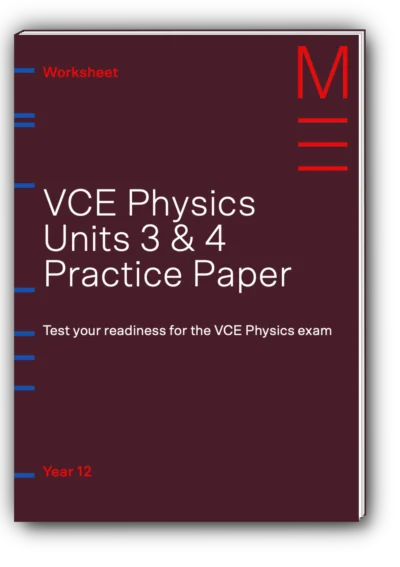Welcome to Matrix Education
To ensure we are showing you the most relevant content, please select your location below.
Select a year to see courses
Learn online or on-campus during the term or school holidays
Learn online or on-campus during the term or school holidays
Learn online or on-campus during the term or school holidays
Learn online or on-campus during the term or school holidays
Learn online or on-campus during the term or school holidays
Learn online or on-campus during the term or school holidays
Learn online or on-campus during the term or school holidays
Learn online or on-campus during the term or school holidays
Learn online or on-campus during the term or school holidays
Learn online or on-campus during the term or school holidays
Select a year to see available courses
Science guides to help you get ahead
Science guides to help you get ahead
Prep for the VCE Physics exam with these exam-style questions and full solutions. Cover light as a particle, light as a wave, wave-particle duality and special relativity.

Join 75,893 students who already have a head start.
"*" indicates required fields
Related courses

Join 8000+ students each term who already have a head start on their school academic journey.
Are you getting ready for your VCE Physics exam? This practice paper has been designed to help you apply your knowledge to exam-style questions and sharpen your problem-solving skills.
But first, check out our VCE Physics Study Guide: How to Ace Your Exam for expert tips on study techniques, time management, and how to approach different question types.
Below, we’ve pulled out one sample question from each major topic to give you a feel for what to expect. Try them out on your own.
Then grab the full paper (with solutions!) using the download form at the end.
Question:
Blue light has a wavelength of 470 nm. Calculate the period of the wave. (1 mark)
Hint: Use the wave relationship \(T = \frac{1}{f}\), and remember that \(v = f \lambda\) for electromagnetic waves in a vacuum.
Question:
The energy of one photon emitted from an X-ray source is measured to be 0.781 keV. Calculate the wavelength of the X-rays. Give your answer in nanometres. Show all working. (3 marks)
Hint: Use the formula \(E = \frac{hc}{\lambda}\). Don’t forget to convert energy units correctly!

Question:
Electrons of mass \(9.1 \times 10^{-31}\) kg have a de Broglie wavelength of
. Calculate the speed of the electrons. (1 mark)
Hint: Rearranging de Broglie’s equation \(\lambda = \frac{h}{p}\) will help here.
Question:
“The speed of light, in a vacuum, is dependent on the motion of the observer.” Is this statement true or false? Explain your answer. (1 mark)
Hint: Think Einstein. The postulates of special relativity are your best friend here.
If you’d like to see how recent exam questions are answered, check out our 2024 VCE Physics Exam Solutions — a full breakdown of the 2024 VCE Physics exam with explanations and working.
Want Band 6 Physics resources?
Learn from expert HSC Physics teachers and structured lessons. See why 8000+ join Matrix each term.
Solution:
\(T = \frac{\lambda}{v}\)
\(T = \frac{470 \times 10^{-9}}{3.0 \times 10^8}\)
\(T = 1.57 \times 10^{-15} \; \text{s}\)
Answer:
Solution:
\(0.781 \times 10^3 = \frac{4.14 \times 10^{-15} \times 3.0 \times 10^8}{\lambda}\) *use h in eVs, not Js
\(\lambda = \frac{4.14 \times 10^{-15} \times 3.0 \times 10^8}{0.781 \times 10^3}\) \(\lambda = 1.59 \times 10^{-9} \; \text{m} = 1.59 \; \text{nm}\)Answer:
Solution:
\(\lambda = \frac{h}{p} = \frac{h}{mv}\)
\(4.21 \times 10^{-6} = \frac{6.63 \times 10^{-34}}{9.1 \times 10^{-31} \times v}\)
\(v = \frac{6.63 \times 10^{-34}}{9.1 \times 10^{-31} \times 4.21 \times 10^{-6}}\)
\(v = 1.73 \times 10^2 \; \text{m/s}\)
Answer:
Answer:
Einstein’s second postulate states that the speed of light in a vacuum is constant, regardless of the motion of the observer or source of the light. Therefore, the statement is false.
These are just a few of the 50+ questions waiting for you in our full VCE Physics Units 3 & 4 Practice Paper. It includes:
Multiple choice and short answer questions
Topics aligned with the VCE Study Design
Separate, fully worked solutions

Download this to test your knowledge of VCE Physics Units 3 & 4 and fine-tune your skills.

Fill out your details below to get this resource emailed to you.
"*" indicates required fields
Written by Jill Tengco
Jill is the Content Marketing Specialist at Matrix Education. She holds a Bachelor of Media (Communication and Journalism) from the University of New South Wales and is passionate about creating educational content that helps students succeed.© Matrix Education and www.matrix.edu.au, 2025. Unauthorised use and/or duplication of this material without express and written permission from this site’s author and/or owner is strictly prohibited. Excerpts and links may be used, provided that full and clear credit is given to Matrix Education and www.matrix.edu.au with appropriate and specific direction to the original content.